Tips for healthy summer diet
Have you ever been determined to watch what you eat on holiday? If so, we’ve got all the phase! Then you exactly how hard it can be to abstain and not get tempted! Because on the beach.. in the spa, you can be lured into sin by more and more delicious food specialities. Don’t worry, we’re here to help! Here are the best summer diet tips!

The special about this article is that we will not just talk in generalities, but we will give you concrete examples of what to eat when you are going to travelling! Vitamin360 has taken its most culinary side and tasted the world for you! We’ll show you different ethnicities’ low-calorie but fresh local produce! Remember, holidays are about experiences. So try something new! Try something different and put your „health-sniffing” aside for a bit. Have fun! Live well, because you deserve it! And Vitamin360’s healthy summer eating tips will help you minimise the ’damage’.
And remember, it all starts with summer hydration! For most of us, drinking water is highly underrated and hydration is much more necessary in the heat. Let us show you why!
And at the end of the article we’ll bring you some summer-specific supplements. That’s why worth to sticking with us!
SUMMER DIET TIPS
I beg you, don’t take the scales with you on holiday! How will you know how much energy you’ve had in a day? You won’t know exactly, but you don’t need to know during your holiday! A few days or a few weeks is not much to spoil what you have built up so far! Unless you go into food destruction mode and just binge from morning till night.
By following a few principles, you can cut down on the calories you eat. Instead of counting calories to the minute, use these summer diet tips!
1. Intermittent fasting: if you skip meals, you’ve already saved calories. This fasting can take many forms; some people eat only once a day, others follow a 16:8 fast, which means they limit their meal intervals to eight hours. It’s up to you and your family whether you eat in the first half of the day or the last. The health benefits of fasting are most apparent after 16 hours. Therefore these ’short’ fasts should be seen more as a tool to help you save calories! You can also drink coffee during the fast; good quality coffee consumed on an empty stomach upset (of course, it can cause problems for those who are prone to it). Pro tip: add a little cream to your morning espresso! Cream is low in sugar, but the fat in it fills you up, so you can push back the time of your first meal even more. And consider fasting as a lifestyle change rather than a diet. Many people can use it for months with relatively little effort.
2. Don’t be afraid of carbs, but keep them in control! I don’t know about you, but I’m most tempted by the sight of fresh croissants, pasta and pizza. Not for nothing; Italians are masters of food preparation! If you get a craving during the holiday, eat them, but not as your first meal after lent. Because quickly available carbohydrates will suddenly raise your blood sugar and then rock it. What do you crave when your blood sugar drops? More carbs and more sugar! So, if you start with that after fasting, you’ll crave more of the same carbohydrate-rich foods in the little time you eat. Before that, be sure to have a lot of vegetablesin your first meal, then for the next 1-2 meals start to ’play’ a bit, try 1-1 portion of fresh local produce pastries and even sweets. Don’t worry about the calories, because it’s much harder to overeat if you restrict them over time! Pro tip: if your food contains almost exclusively fast-absorbing carbohydrates, use a little fiber powder on the side (once a day) to slow down their absorption. A good choice for this is: Now Foods Acacia Fiber Organic Powder. Don’t forget to drink extra water then using fibre powder, otherwise it can have a stomach choking effect.
3. Eat enough protein! I know, this is nothing new, but also from my own experience. When I’m tasting the specials of a place, I’m mostly eating a lots of fibre because of the vegetables and a lot of carbs and fats because of the pastries and sweets. Pasta and one-dish meals are also mostly carbohydrate and fat. So if you find that you are not getting enough protein intake per day, push a little protein shake or bar between meals. Trust me, by the time you get back into your workout routine your muscles and strength will thank you!
Protein powder for vegans: Now Foods Plant Protein Complex
Protein powder for meat lovers: MuscleMeds Carnivor™
Protein powder for those with a stomach that can tolerate milk: Nutrend 100% Whey Protein
SUMMER HYDRATION
Some interesting facts about water consumption1: water is a medium in our bodies through which chemical processes can take place. Water is essential for the proper functioning of the cardiovascular system. On average, 70% of an adult’s body weight is water, but this figure decreases with age: in the elderly, the average water content is 50%. Waterloss is associated with side effects at just 1%, but dehydratation at 10% and above is a life-threatening condition. People are unable to adapt to chronic water shortages, so the water they lose must be replaced! Okay. Okay. So far everyone probably knew all this, but do you know how much we sweat on average with physical activity? Maximum sweating can range from 1.5 litres to 3 litres per hour! As an example, marathon runner Alberto Salazar holds the record for maximum hourly sweat: he measured 3.71 litres per hour at the 1984 Olimpics.
Crazy big numbers, right? So, when you’re out walking on holiday, know what you’re probably sweating more than you first think. So make sure you drink more water!

DIETARY SUPPLEMENTS FOR SUMMER
Now Foods Omega 3 Fish Oil and Now Foods Green Tea Extract
Omega 3 and green tea extract would be essential in summer. Although both products can be used long term (high quality Omega 3 is highly recommended)2,3, they can have a marked effect in summer! If you are using green tea for long term use it is better to stick to lower doses (200 mg), but if you are using it intermittently or in summer you may want to increase the dose to 400 mg. Why should you take more green tea in summer?
In the summer UV radiation is stronger and we are in the sun more. We are therefore more exposed to the harmful effects of the sun. This means that free radicals will be released in our cells damaged by UV radiation (these are the damaging agents themselves). To protect against free radicals, we need antioxidants. Green tea is considered a very powerful antioxidant and Omega 3s relieve the immune system by reducing cellular inflammation (thus indirectly strengthening it).
All they need is a basic multivitamin that doesn’t overdose, like Life Extension Two-Per-Day Capsule! With this multivitamin we can cover the whole spectrum of antioxidants. Because vitamins also have antioxidant properties, but each active ingredient protects a little bit differently against certain free radicals.
COQ10, MCT Oil and Life Extension AMPK Activator
There’s a product that energises you, protects you from the sun as an antioxidant and even has a nourishing effect! This three-in-one product is Now Foods COQ10, which is carried by MCT oil. Coenzyme Q10 plays a key role in the energy production of our cells.4 Q10 is also one of the most important energy cofactors. These substances are generally considered to have antioxidant properties (because their role in energy production favours electron migration6 and harmful free radicals deplete electrons from our cells) and accelerate metabolism, i.e. stimulate weight loss.5 The latter is also helped by MCT oil, which stimulates cells to use fat for energy in a sugar-deficient state (i.e. increases the chance of entering ketosis).7 And the consuming effects only kick in when you are in a calorie deficit and/or eating a low-carbohydrate diet. They can and should be used anyway if weight loss is not the primary goal. Pro tip: use COQ10 and MCT Oil at the begining of intermittent fasting.
A herb with a similar effect is the main active ingredient in Life Extension AMPK Activator: five-fingered ginseng. It’s extract has been shown in studies to help you achieve a more ideal body composition!8-12 It can be beneficial for fat loss and works in a similar way to coenzyme Q10, with the difference that it stimulates a different energy pathway. Pro tip: COQ10 and MCT Oil together with Life Extension AMPK Activator, is used at the beginning of intermittent fasting.
FRESH LOCAL FOODS
Are you ready? Here are the super-healthy but delicious dishes (not to be exhaustive)! Be sure to try these if you’re on holiday in one of the popular tourist destinations!
SPAIN
1. Paella: The secret of the Spanish speciality is saffron. It is a rice dish prepared with sea food (or even meat) and lots of vegetables.
Energy: 450 kcal/serving (about 300g), protein: 20g, carbohydrates: 50g, fat: 18g
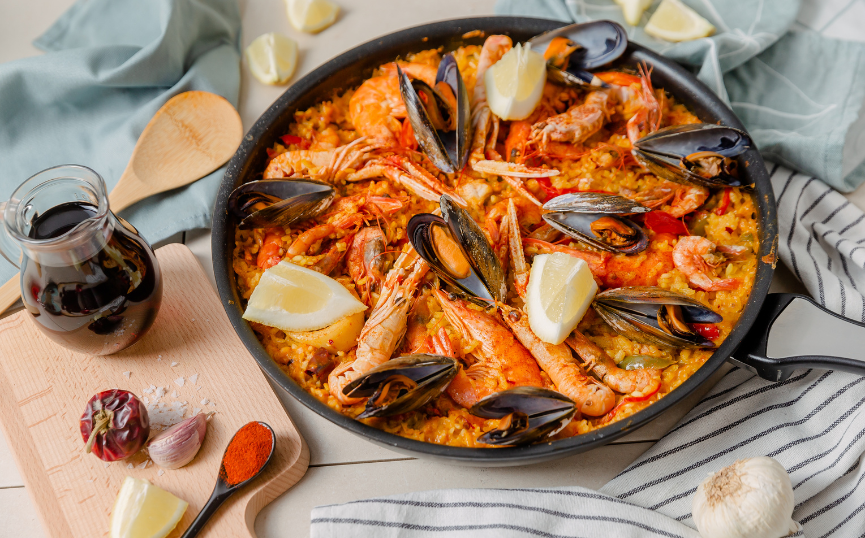
Gazpacho: Did you ever think a vegetable soup could be delicious cold? It’s made from tomatoes, peppers, cucumbers and onions, and is served cold. In the sweltering heat of the Spanish summers, it’s refreshing and low in calories!
Energy: 120 kcal/serving (about 300g), protein: 2g, carbohydrates: 15g, fat: 5g
Tortilla Española: omlette with a difference, a little bit Spanish. Tortilla Española is an egg dish made with potatoes and onions. Choose this if you want a filling breakfast!
Energy: 250 kcal/serving (200 g), protein: 8g, carbohydrates: 5g, fat: 20g
FRANCE
1. Ratatouille: Known as French Ratatouille, it is mostly made in Provence. It is different in texture and taste from our Ratatouille. It is more compote-like, usually lacks paprika and is baked in the oven.
Energy: 150 kcal/serving (about 200 g), protein: 3 g, carbohydrates: 20 g, fat: 7 g
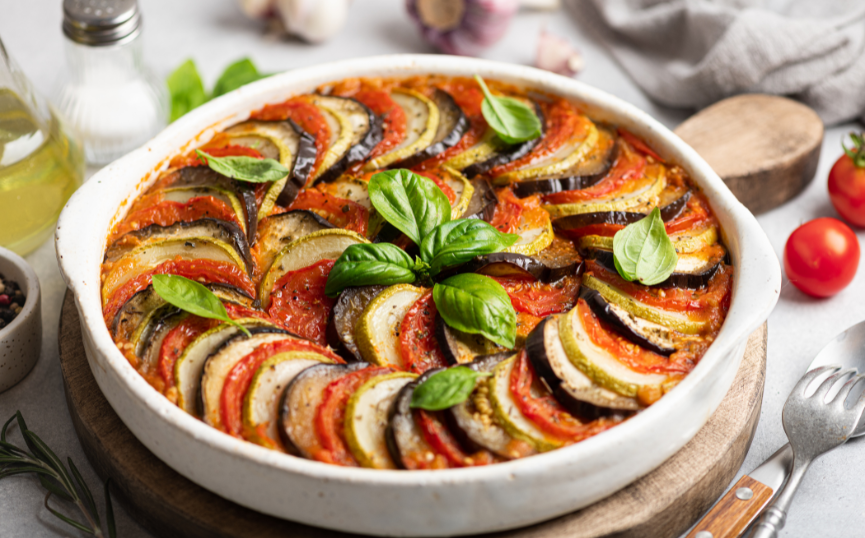
2. Quiche Lorraine: The france savoury pie is a more calorie-dense dish, but if you’re in France, don’t miss it! It has everything that makes a delicious source of protein: cream, eggs, bacon and cheese.
Energy: 300 kcal/serving, protein: 12 g, carbohydrate: 20g, fat: 20g
3. Nicoise salad: If you want to make sure you save calories, go for the Nicoise salad! It consists of tuna, hard boiled eggs, green beans, potatoes and olives.
Energy: 350 kcal/serving (150 g), protein: 20 g, carbohydrates: 25 g, fat: 15 g
ITALY
1. Minestrone: If you love pizza, you’ll love this Italian vegetable soup! Topped with Parmesan cheese and the typical Italian seasoning. You will not be disappointed!
Energy: 200 kcal/serving (about 250 g), protein: 7 g, carbohydrates: 35 g, fat: 4 g
2. Caprese salad: Another sure-fire safe food. A fresh and light salad is Caprese, made with tomatoes, mozzarella cheese and fresh basil. It seasoned with olive oil and balsamic vinegar. Its low calorie content makes it a sure-fire option.
Energy: 200 kcal/serving (about 250 g), protein: 8 g, carbohydrates: 15 g, fat: 5 g
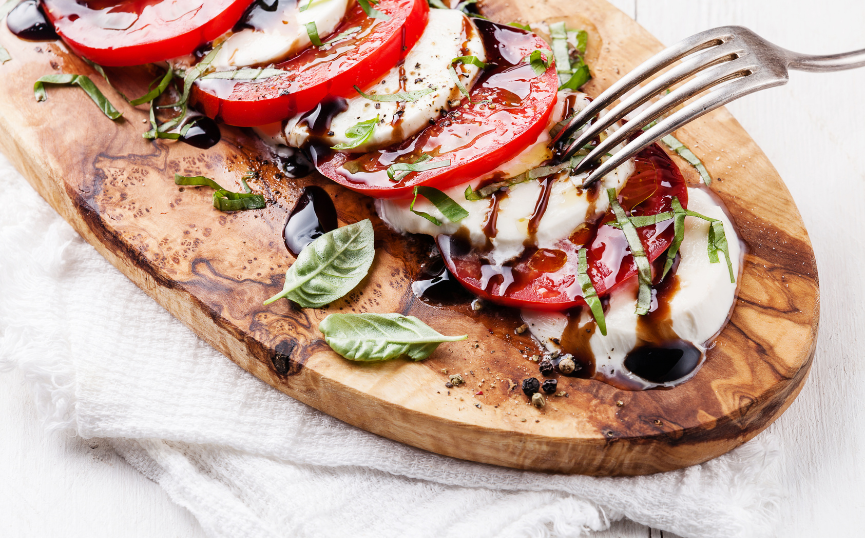
3. Osso Buco: Gourmet veal shank, slow cooked in a tomato and vegetable base. It is best served with a lemon and parsley mixture. The special sauce and the veal make it a particularly rich and filling dish, often served with polenta (Italian porridge) or risotto.
Energy: 400 kcal/serving (about 300 g), protein: 30 g, carbohydrates: 15 g, fat: 25 g
PORTUGAL
1. Bacalhau à Brás: With cod, eggs, potatoes and onions. In terms of texture, I could probably place it somewhere between a stew and a pâté. Bacalhau á Brás is a traditional Portuguese dish, often prepared for festive occasions. If you are in Portugal, you should try it, not only for its balanced macronutrient proportions, but also for its special taste.
Energy: 350 kcal/serving (about 200 g), protein: 20 g, carbohydrates: 20 g, fat: 20 g
2. Caldo Verde: Kale soup, the Portuguese way. Caldo Verde is made with kale, potatoes, onions and sausages. It is simple but rich in flavour.
Energy: 150 kcal/serving (about 200 g), protein: 5 g, carbohydrates: 15 g, fat: 8 g
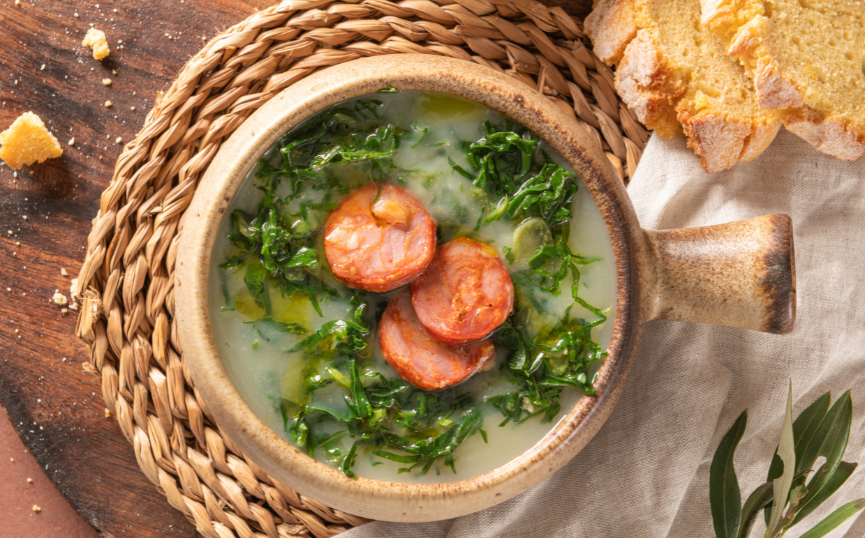
3. Caldeirada: Or fish soup, which is made from a variety of seafood and cooked with vegetables such as potatoes, onions, tomatoes and peppers. It is rich in lactose and, because of its high water content, it is still considered low in calories, despite the richness of its ingredients.
Energy: 300 kcal/adag (about 350 g), protein: 25 g, carbohydrates: 30 g, fat: 10 g
EASTERN EUROPE
1. Borscs (Russia): Peppercorns is a Russian beetroot soup that often contains cabbage, potatoes and meat. Its special flavour lies in the combination of vinegar and beetroot. It is most popular served with sour cream.
Energy: 150 kcal/serving (about 250 g), protein: 6 g, carbohydrates: 20 g, fat: 5 g
2. Pierogi (Poland): Pierogi is a Polish stuffed pastry, often made with potatoes, cheese or a meat filling. Perhaps I could compare it to the Tortellino pasta that everyone knows.
Energy: 220 kcal/serving (about 4 pcs), protein: 6 g, carbohydrates: 40 g, fat: 5 g
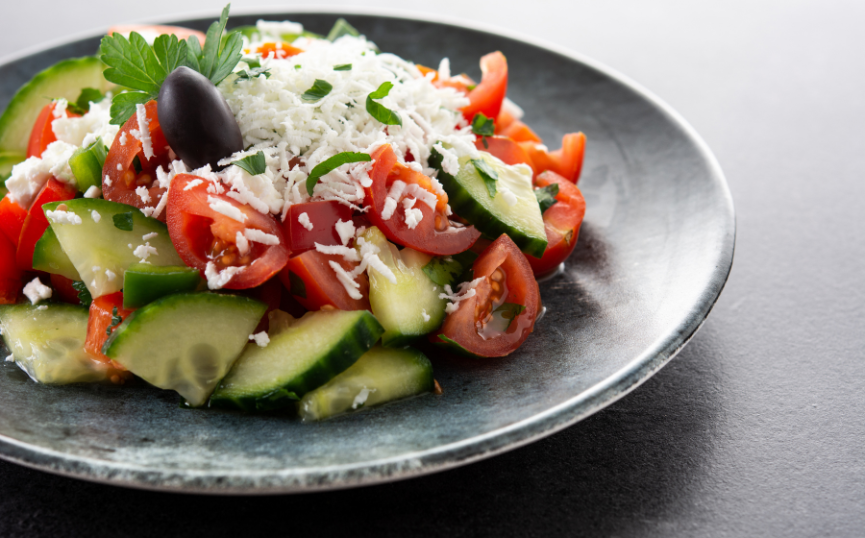
3. Shopska salad (Bulgaria): Shopska salad is a fresh Bulgarian salad made from tomatoes, cucumber, onion and white cheese. It is seasoned with olive oil and vinegar. Believe me, there is a difference a salad and a lettuce. It’s made with very different seasonings by Italians or even Greeks and it’s seasoned differently by Bulgarians.
Energy: 120 kcal/serving (about 200 g), protein: 4 g, carbohydrates: 10 g, fat: 8 g
- Institute of Medicine (US) Committee on Military Nutrition Research; Marriott BM, editor. Nutritional Needs in Hot Environments: Applications for Military Personnel in Field Operations. Washington (DC): National Academies Press (US); 1993. 5, Water Requirements During Exercise in the Heat. Available from: https://www.ncbi.nlm.nih.gov/books/NBK236237/
- EFSA Panel on Food Additives and Nutrient Sources added to Food (ANS); Younes M, Aggett P, Aguilar F, Crebelli R, Dusemund B, Filipič M, Frutos MJ, Galtier P, Gott D, Gundert-Remy U, Lambré C, Leblanc JC, Lillegaard IT, Moldeus P, Mortensen A, Oskarsson A, Stankovic I, Waalkens-Berendsen I, Woutersen RA, Andrade RJ, Fortes C, Mosesso P, Restani P, Arcella D, Pizzo F, Smeraldi C, Wright M. Scientific opinion on the safety of green tea catechins. EFSA J. 2018 Apr 18;16(4):e05239. doi: 10.2903/j.efsa.2018.5239. PMID: 32625874; PMCID: PMC7009618.
- https://ods.od.nih.gov/factsheets/Omega3FattyAcids-HealthProfessional/
- Raizner AE. Coenzyme Q10. Methodist Debakey Cardiovasc J. 2019 Jul-Sep;15(3):185-191. doi: 10.14797/mdcj-15-3-185. PMID: 31687097; PMCID: PMC6822644.
- Xu Z, Huo J, Ding X, Yang M, Li L, Dai J, Hosoe K, Kubo H, Mori M, Higuchi K, Sawashita J. Coenzyme Q10 Improves Lipid Metabolism and Ameliorates Obesity by Regulating CaMKII-Mediated PDE4 Inhibition. Sci Rep. 2017 Aug 15;7(1):8253. doi: 10.1038/s41598-017-08899-7. PMID: 28811612; PMCID: PMC5557856.
- Sood B, Patel P, Keenaghan M. Coenzyme Q10. [Updated 2024 Jan 30]. In: StatPearls [Internet]. Treasure Island (FL): StatPearls Publishing; 2024 Jan-. Available from: https://www.ncbi.nlm.nih.gov/books/NBK531491/
- Lin TY, Liu HW, Hung TM. The Ketogenic Effect of Medium-Chain Triacylglycerides. Front Nutr. 2021 Nov 18;8:747284. doi: 10.3389/fnut.2021.747284. PMID: 34888335; PMCID: PMC8650700.
- Park SH, Huh TL, Kim SY, Oh MR, Tirupathi Pichiah PB, Chae SW, Cha YS. Antiobesity effect of Gynostemma pentaphyllum extract (actiponin): a randomized, double-blind, placebo-controlled trial. Obesity (Silver Spring). 2014 Jan;22(1):63-71. doi: 10.1002/oby.20539. Epub 2013 Sep 5. Erratum in: Obesity (Silver Spring). 2015 Dec;23(12):2520. doi: 10.1002/oby.21362. Erratum in: Obesity (Silver Spring). 2020 Sep;28(9):1770-1773. doi: 10.1002/oby.22991. PMID: 23804546.
- Lee HS, Lim SM, Jung JI, Kim SM, Lee JK, Kim YH, Cha KM, Oh TK, Moon JM, Kim TY, Kim EJ. Gynostemma Pentaphyllum Extract Ameliorates High-Fat Diet-Induced Obesity in C57BL/6N Mice by Upregulating SIRT1. Nutrients. 2019 Oct 15;11(10):2475. doi: 10.3390/nu11102475. PMID: 31618980; PMCID: PMC6835433.
- Md Abdul Aziz, Md Shalahuddin Millat, Tahmina Akter, Md Shahadat Hossain, Md Monirul Islam, Shahriar Mohsin, Farzana Ansari, Asma Kabir, Mohammad Nurul Amin, Mohammad Safiqul Islam,
- A comprehensive review on clinically proven medicinal plants in the treatment of overweight and obesity, with mechanistic insights, Heliyon, Volume 9, Issue 2, 2023, e13493, ISSN 2405-8440,
- Li Y, Chen Y. AMPK and Autophagy. Adv Exp Med Biol. 2019;1206:85-108. doi: 10.1007/978-981-15-0602-4_4. PMID: 31776981.










